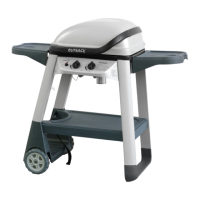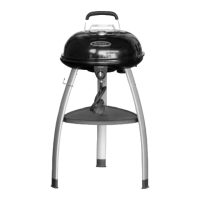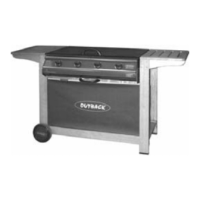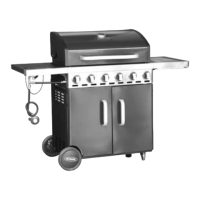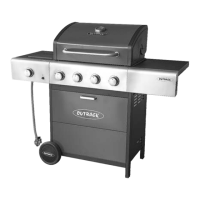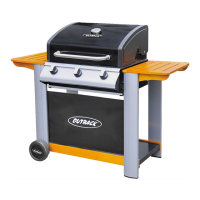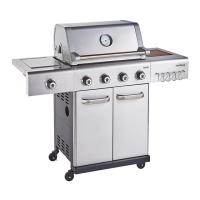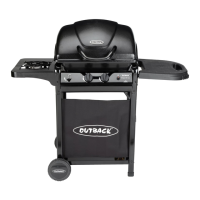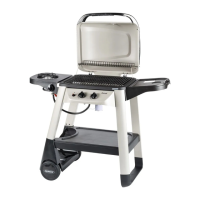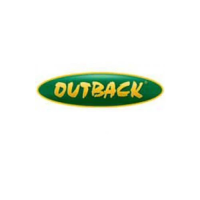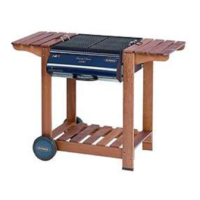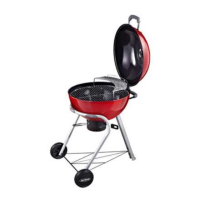13
H8. Rotisserie Operation Instructions
1. Carefully remove the cast iron cooking surfaces
and the warming rack from the barbecue.
2. For 3 and 4 burner models, slide the lava rock
basket(s) to the center of the barbecue body. It is
over this area that the meat will be cooked.
3. Slide one of the spit forks onto the spit rod and
tighten its thumb screw to secure it into place.
Insert the pointed end of the spit rod into the
meat being cooked and slide the meat towards
the center of the rod. Make sure the fork is fully
into the meat. Slide the other fork onto the rod,
into the meat, and tighten the thumb screw once
in place. For optimal rotisserie cooking, food
must be placed securely onto the middle of the
spit rod and balanced so that the rotisserie can
rotate freely without interference from any
barbecue surfaces. Any loose sections of meat
should be secured so they do not hang down and
interfere with the rotation of the spit rod.
4. Insert the pointed end of the spit rod into the
motor. Lay the other end of the spit rod onto the
opposite bracket.
5. Light the grill as specified in your barbecue’s
instructions.
6. Turn on the rotisserie motor to begin rotisserie
cooking. The hood has been designed so that it
may be closed during rotisserie cooking.
7. Always cook foods on the lowest flame setting to
avoid burning or overcooking.
H9. Flare-Up Control
Flare-ups occur when meat is barbecued, and its fat
and juices fall upon the hot lava rock. Smoke helps
give food its barbecued flavor, but avoid excessive
flare-up to prevent food being burned. To control
flare-up, it is advisable to trim away excess fat from
meat and poultry before grilling. The burners should
always be placed on the low setting during cooking.
Flare-ups can be extinguished by applying baking
soda or salt directly onto the lava rocks. Always
protect your hands when handling anything near the
cooking surface of the barbecue.
If a fat fire should occur in the drip tray, turn all knobs
to the off position, turn off the gas at the bottle, and
wait for the fire to go out. Do not pull out the drip tray
or douse with water.
H10. End of Cooking Session
After each cooking session, turn the barbecue
burners to the “high” position and burn for 5 minutes.
This procedure will burn off cooking residue, thus
making cleaning easier. Make sure the hood or lid is
open during this process.
H11. Turning Off Your Barbecue
When you have finished using your barbecue, turn all
the control valves fully clockwise to the “Off” position,
then switch off the gas at the bottle.
I. CARE AND MAINTENANCE
Regularly clean your barbecue between uses and
especially after extended periods of storage. Ensure
the barbecue and its components are sufficiently cool
before cleaning. Do not leave the barbecue exposed
to outside weather conditions or stored in damp,
moist areas.
nNever douse the barbecue with water when its
surfaces are hot.
nNever handle hot parts with unprotected hands.
In order to extend the life and maintain the condition
of your barbecue, we strongly recommend that the
unit be covered when left outside for any length of
time, especially during the winter months. Heavy-
duty Outback® barbecue covers and other
accessories are available from your local Outback®
sto cki st.
I1. Porcelain Coated Cast Iron Cooking Surfaces
Clean with hot, soapy water. To remove any food
residue, use a mild cream cleaner on a non-abrasive
pad. Rinse well and dry thoroughly. We do not
recommend cleaning grills and griddles in a
dishwasher.
I2. Burner Maintenance
Provided that they are operating correctly, in normal
usage, burning off the residue after cooking will keep
the burners clean. The burners should be removed
and cleaned annually, or whenever heavy build-up is
found, to ensure that there are no signs of blockage
(debris, insects) in either the burner portholes or the
primary air inlet of the cast iron burners. Use a pipe
cleaner to clear obstructions. A wire brush can be
used to remove corrosion from the burner surfaces. It
is quite normal for surface rust to be present on the
burners. When refitting the burners, be careful to
check that the neck of the burner fits over the valve
outlet.
I3. Lava Rock
It is not necessary to remove and wash the lava rock
in order to keep it clean. Burning off the residue after
each cooking should be sufficient. Heavily
impregnated lava rock should be turned over so that
the dirty side faces the burners in order to burn off
any residue. Replacement lava rock is available from
your local Outback® stockist.
I4. Drip Tray
After every use, check the drip tray for fat build-up in
the sand. Discard any saturated sand and replace it
with fresh sand. Failure to fill with sufficient clean,
dry, loose sand may result in a fat fire or excessive
flare up. This can severely damage your barbecue
and is not covered by the warranty.
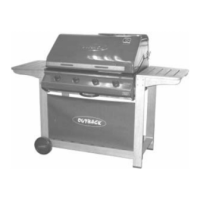
